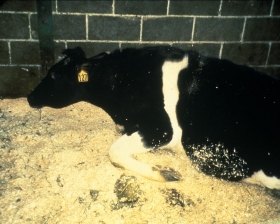Mad Cow Detection

Mad cow disease is a fatal disease in cattle that causes portions of the brain to turn sponge-like. This transmissible disease is caused by the propagation of a misfolded form of protein known as a prion, rather than by a bacterium or virus. The average time from infection to signs of illness is about 60 months. Little is known about the pathogenesis of BSE in the early incubation period. Previous research has reported that the autonomic nervous system (ANS) becomes affected by the disease only after the central nervous system (CNS) has been infected. In a new study published online in the August issue of The American journal of pathology, researchers found that the ANS can show signs of infection prior to involvement of the CNS.
Bovine spongiform encephalopathy (BSE), commonly known as mad cow
disease, is a fatal neurodegenerative disease in cattle that causes a
spongy degeneration in the brain and spinal cord. BSE has a long
incubation period, about 30 months to 8 years, usually affecting adult
cattle at a peak age onset of four to five years, all breeds being
equally susceptible. In the United Kingdom, the country worst affected,
more than 180,000 cattle have been infected and 4.4 million slaughtered
during the eradication program.
The infectious agent in BSE is believed to be a specific type of
misfolded protein called a prion. Prions will not disappear even if the
beef containing them is cooked. Prion proteins carry the disease between
individuals and cause deterioration of the brain. BSE is a type of
transmissible spongiform encephalopathy. This can arise in animals that
carry an allele which causes previously normal protein molecules to
contort by themselves from an alpha helical arrangement to a beta
pleated sheet, which is the disease-causing shape for the particular
protein.
Transmission can occur when healthy animals come in contact with tainted
tissues from others with the disease. In the brain, these proteins cause
native cellular prion protein to deform into the infectious state, which
then goes on to deform further prion protein in an exponential cascade.
This results in protein aggregates, which then form dense plaque fibers,
leading to the microscopic appearance of "holes" in the brain,
degeneration of physical and mental abilities, and ultimately death.
A distinct accumulation of the pathological prion protein was observed
in the gut in almost all studied samples. BSE prions were found in the
sympathetic ANS system, located in the thoracic and lumbar spinal cord,
starting at 16 months after infection; and in the parasympathetic ANS,
located in the sacral region of the spinal cord and the medulla, from 20
months post infection. There was little or no sign of infection in the
CNS in these samples. The sympathetic part of the ANS was more widely
involved in the early pathogenesis than its parasympathetic counterpart.
More bovines showing clinical symptoms revealed signs of infection in
the sympathetic nervous system structures at a higher degree than in the
parasympathetic tissue samples. The earliest detection of BSE prions in
the brainstem was at 24 months post infection. However, infection
detected in the spinal cord of one animal at 16 months post infection
suggests the existence of an additional pathway to the brain.
"The clear involvement of the sympathetic nervous system illustrates
that it plays an important role in the pathogenesis of BSE in cattle,"
notes Dr. Groschup. "Nevertheless, our results also support earlier
research that postulated an early parasympathetic route for BSE."
The results, Dr. Groschup says, indicate three possible neuronal routes
for the ascension of BSE prions to the brain: sympathetic,
parasympathetic, and spinal cord projections, in order of importance.
"Our study sheds light on the pathogenesis of BSE in cattle during the
early incubation period, with implications for diagnostic strategies and
food-safety measures."
The disease may be most easily transmitted to human beings by eating
food contaminated with the brain, spinal cord or digestive tract of
infected carcasses. However, it should also be noted that the infectious
agent, although most highly concentrated in nervous tissue, can be found
in virtually all tissues throughout the body, including blood. In
humans, it is known as new variant Creutzfeldt—Jakob disease, and by
October 2009, it had killed 166 people in the United Kingdom, and 44
elsewhere.
For further information see
Disease.
Cow image via Wikipedia.
©2012. Copyright Environmental News Network To subscribe or visit go to: http://www.enn.com